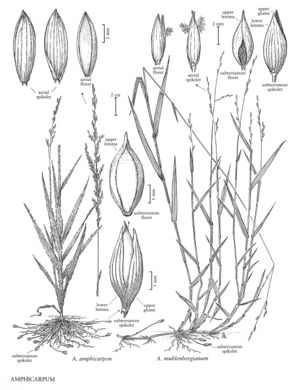Difference between revisions of "Amphicarpum muhlenbergianum"
imported>Volume Importer |
imported>Volume Importer |
||
| (One intermediate revision by the same user not shown) | |||
| Line 41: | Line 41: | ||
|publication year= | |publication year= | ||
|special status=Endemic | |special status=Endemic | ||
| − | |source xml=https:// | + | |source xml=https://bitbucket.org/aafc-mbb/fna-data-curation/src/200273ad09963decb8fc72550212de541d86569d/coarse_grained_fna_xml/V25/V25_1098.xml |
|subfamily=Poaceae subfam. Panicoideae | |subfamily=Poaceae subfam. Panicoideae | ||
|tribe=Poaceae tribe Paniceae | |tribe=Poaceae tribe Paniceae | ||
Latest revision as of 17:55, 11 May 2021
Plants perennial. Culms 30-100 cm, usually decumbent, sometimes erect. Leaves evenly distributed; sheaths usually glabrous, occasionally sparsely hirsute; blades to 10(13) cm long, 5-10.5 mm wide, glabrous, margins white. Subterranean spikelets 6-9 mm, acuminate. Aerial panicles 3-20 cm; aerial spikelets 5.5-7 mm, narrowly lanceoloidal. 2n = 18.
Discussion
Amphicarpum muhlenbergianum grows in damp areas, such as dried pond bottoms, ditches, flatwoods, and swampy pinewoods of the southeastern United States.
Selected References
None.
Lower Taxa
None.
